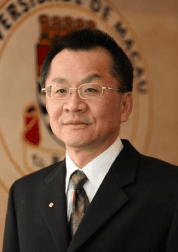ACAIT 2020
The 4th Asian Conference on Artificial Intelligence Technology
October 16-18 2020, Chongqing, China
Keynote & Invited Speeches
-
Keynote Speech 1

Qionghai Dai
Academician of Chinese Academy of Engineering, China
Dean of the School of Information Science and Technology of Tsinghua University Dean of the Institute of Brain and Cognitive Sciences of Tsinghua University President of Chinese Association for Artificial Intelligence
Title: Artificial Intelligence - Interaction
Abstract:The development of human society has gone through the industrial revolution, electrical revolution and information revolution, and has officially entered the era of artificial intelligence. The core task of artificial intelligence is to empower humans and develop harmoniously with them. Therefore, the interaction between artificial intelligence and human beings and the physical world is the key to truly improving human cognition and the ability to transform the world, and can change the future social form and service mode. Focusing on the above-mentioned interaction issues, the report explains the technical challenges and development opportunities of the two core interaction technologies in the future: augmented reality interaction with humans and physical interaction with the physical world, shows several disruptive user experience cases, And looks forward to the prospects of how to promote human cognition, development and cultural and artistic changes.
-
Keynote Speech 2

C. L. Philip Chen
Distinguished Chair Professor of South China University of Technology
Member of Academia Europaea
Vice-President of Chinese Association of Automation
IEEE Fellow, AAAS Fellow
Title:Recurrent and Gated Broad Learning Systems: an LSTM-Like Architecture and its Applicationsin Simultaneous Learning of Time-Related Information
Abstract:In this talk, the broad learning system(BLS) will be briefly discussed. Then its variations in recurrent structure, Recurrent BLS (RBLS) and long-shorttermmemory (LSTM)-like architectures by adding forget gates function, Gated BLS (GBLS), will be discussed along with the learning algorithms. Recurrent BLS and Gated BLS and associated learning algorithms possess three advantages: 1) higher accuracydue to the simultaneous learning of multiple information,even compared to deep LSTM that extracts deeper but singleinformation only; 2) significantly faster training time dueto the noniterative learning in BLS, compared to LSTM; and3) easy integration with other discriminant information for furtherimprovement. The proposed methods have been evaluatedover 13 real-world datasets from various types of text classification.Compared to RBLS, GBLS hasan extra forget gate to control the flow of information (similarto LSTM) to further improve the accuracy on text classification. From the experimental results, the proposed methodsachieve higher accuracies than that of LSTM while taking significantlyless training time on most evaluated datasets, especially when theLSTM is in deep architecture.
-
Keynote Speech 3

Roman Słowiński
Member of Academia Europaea
Vice President of the Polish Academy of Sciences
Professor of Poznań University of Technology, Poland.
IEEE Fellow, IRSS Fellow
Title: Preference learning by robust ordinal regression for multi-attribute decision aiding
Abstract: Recognizing Decision Maker’s (DM’s) preferences is crucial for multiple attribute decision aiding. We present a constructive preference learning methodology, called robust ordinal regression. This methodology links Operational Research with Artificial Intelligence, and as such, it confirms the current trend in mutual relations between OR and AI.
-
Keynote Speech 4

Shuzhi Sam Ge
Professor of National University of Singapore (NUS)
IEEE Fellow, IFAC Fellow, IET Fellow, IES Fellow.
Title:Spiral Advancementof AI and Robotics
Abstract:Robotics and Artificial Intelligence (AI) technologies have been widely employed in our works and daily lives as they are revolutionizing. For new-generation robot, one focus is the ability to have harmonious and natural social interaction with human. This is considered as one of the important signs that human society have entered the era of man-machine integration. In this lecture, I will firstly give a brief introduction about development of robot-human interaction technologies in short-term and specific scenarios, then go through the improvement that AI technologies bring up. I will focus more on the recent research works and advances in the social robotics based on knowledge learning, intelligent control, scene understanding with AI, companionship, and among others. I would like to conclude my lecture by the discussion on comprehensive robot interaction theory that integrates social knowledge, intention understanding, behavior generation and delivery. For each of the subtopics, the materials are prepared with pictures, and followed by some fundamental technical details. At this point of the time, the fusion of AI and robotics is apparent, and open for us to work together to make social robots as an integral part of our social fabric.
-
Invited Speech 1

Fuchun Sun
Professor of Tsinghua University, China
Vice-President of Chinese Association for Artificial Intelligence
IEEE Fellow
Title:Behavior-based Artificial Intelligence:Model and Approaches
Abstract:In the development of human society, the invention and use of machine is an important sign of human being's entering into industrialization, and machine becomes an independent actuator, which realizes the separation of executor and action instruction sender from our human. Furthermore, the emergence of artificial intelligence makes it possible for a machine to become a sender of instructions through interactions with environment and human, and as a result, the sender and executor of the instruction are unified on the machine itself. This report systematically analyzes behavior-based artificial intelligence from evolution of automatic control. Then, taking "how to sense like a human being" as the topic, the talk puts forward the framework of robot active perception, introduces the main achievements of the team in visual multi-target detection, visual tactile representation, multimodal fusion and developmental learning, and takes "how to operate like a human being" as the problem, gives the main achievements of the team in learning smart operation skills such as active imitation learning and preference learning achievements. Next, a new concept “Bcent” is proposed to model the unity of learning and coordination among sensing, cognition and behavior, and a new theoretical framework for behavior learning is proposed yet. Finally, the challenge and problems for behavior AI are discussed.
-
Invited Speech 2

Dong Yue
Professor of Nanjing University of Posts and Telecommunications, China
Dean of School of Automation and School of Artificial Intelligence, Nanjing University of Posts and Telecommunications, China
Changjiang Scholar of the Ministry of Education
Title:信物融合有源配电网的协同智能控制与主动安全防御研究
Abstract:首先介绍配电网发展过程中面临的控制与信物安全的挑战性问题,进一步介绍在协同智能控制方面的研究成果,以及面向信物安全的主动安全防御研究思路和初步成果。最后,提出若干值得进一步研究的问题。
-
Invited Speech 3

Xin Xu
Professor of National University of Defense Technology (NUDT), China
National Distinguished Young Scholar
Title:Advances in Autonomous Control and Hybrid Intelligence of Unmanned Systems
Abstract:This talk analyzes the technical requirements and challenges of intelligent unmanned systems. Some advances in bio-inspired autonomous perception of complex environments and reinforcement learning for optimized decision-making and motion control are introduced. The learning-based cooperative control scheme of human-machine systems will be presented with some recent progresses. At last, the directions for further research and development in related areas are discussed.